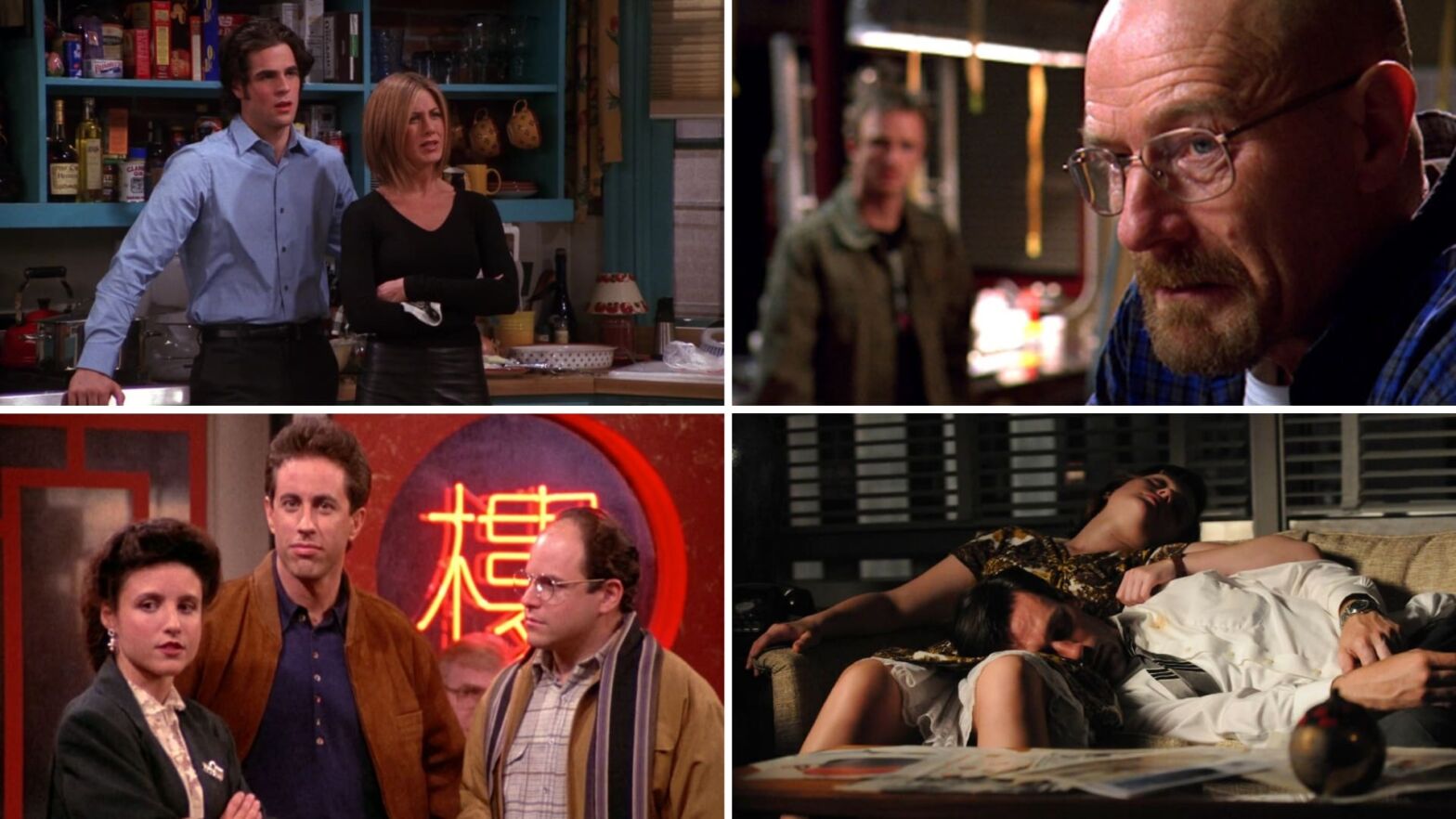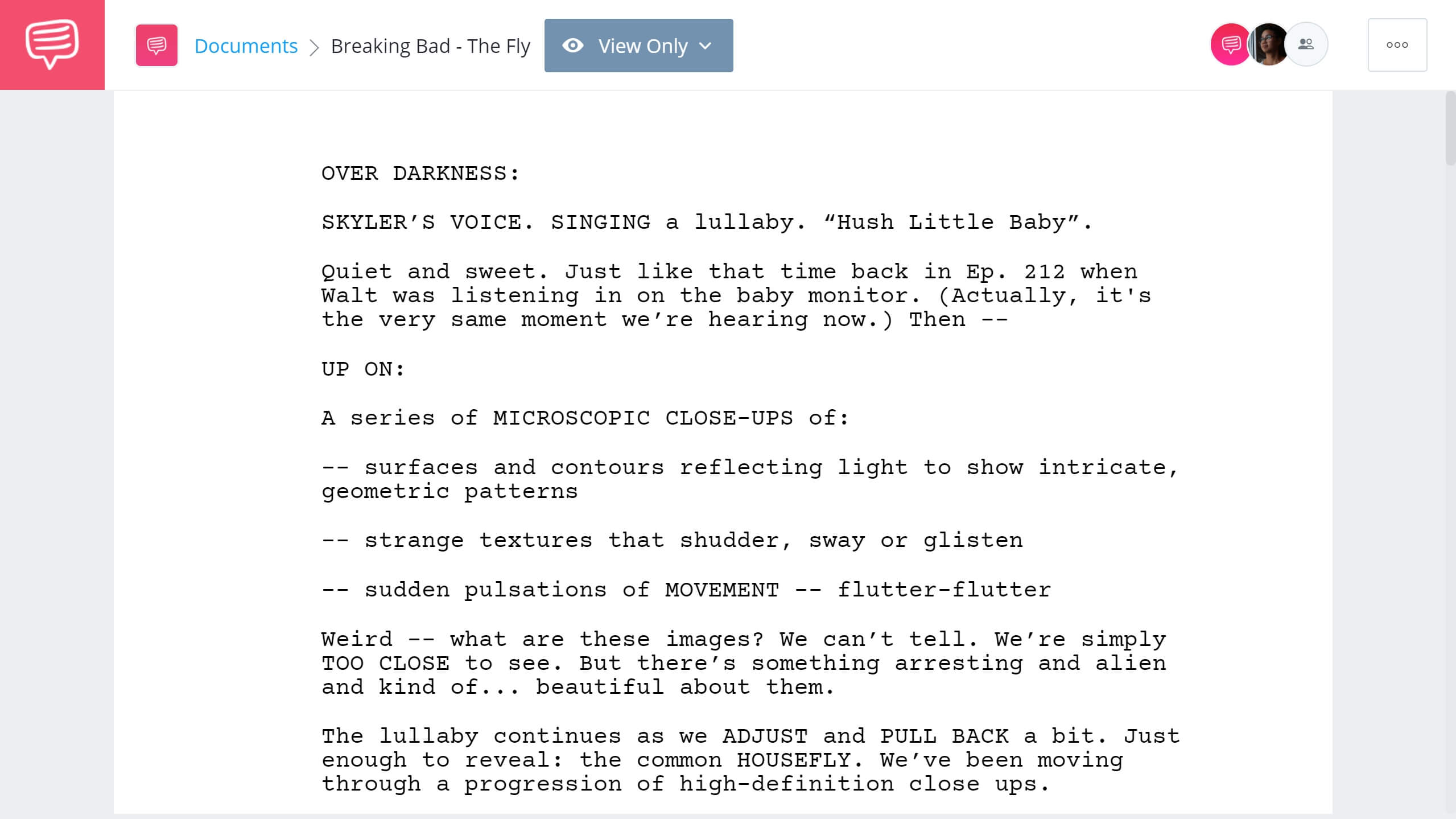If you love TV, then you’ve probably heard of a bottle episode before. Some of the best shows ever from Breaking Bad to Community have used this formula to mixed results. They tend to be some of the most divisive episodes with some fans hating the unique structure while others love what’s made possible through them. But what is a bottle episode? Keep reading to see if your next spec script should have this structure.
WHAT DOES BOTTLE EPISODE MEAN?
How do bottle episodes work?
Walt and Jesse become locked in a room trying to catch a fly in Breaking Bad. Don and Peggy work into the late hours of the night divulging secrets in Mad Men. Both of these are examples of a bottle episode. And once you know the formula, you’ll see it in pretty much all of your favorite shows.
Let's start with a quick definition before moving on to examples of the best bottle episodes and tips on how to write one yourself.
BOTTLE EPISODE DEFINITION
What is a bottle episode?
A bottle episode is a piece of television that has a much smaller scope and uses as little cast members, sets, and effects as possible. Bottle episodes were initially used as a way to save money. By trapping people in a single set, relying heavily on dialogue, the production could use the money elsewhere in the season.
Today, the best bottle episodes aren’t so much done due to financial restraint but for dramatic effect. A smaller cast and limited setting allow for a slower pace. Writers use bottle episodes to do deep dives into characters so that the audience understands them better.
Characteristics of a typical bottle episode:
- Few characters from the main cast
- One location used predominantly throughout
- No big set pieces or special effects
Perhaps Scott Brazil, director/executive producer of The Shield, put it best when he talked about bottle episodes as, “the sad little stepchild whose allowance is docked in order to buy big brother a new pair of sneaks.” And if you want to know how to build out the rest of your TV series in addition to any bottle episodes, StudioBinder has a seven-step course for you to take.
TV Writing & Development Masterclass • Visit the Series Page
Whether you plan on making a web series or writing a spec script, a bottle episode could be your ace in the hole. But how do you create one well that doesn’t bore the viewer? That’s what we’ll get into.
BOTTLE EPISODE MEANING
From economic necessity to useful tool
Television productions receive one budget for the entire season. It’s up to the producers and showrunner to figure out how to allocate that money for 10 to 22 episodes. Show’s often want to make a big splash with a showy season premiere and finale. They may also want to bring in big guest stars who likely want a big paycheck for the appearance.
Not all episodes get an even slice of the pie. The idea of an episode with minimal financial requirements emerged in the 1960s. Shows like Star Trek and The Outer Limits needed to save money for special effects in their season. This forced the writers’ room to think outside of the box and only use sets and actors they already had to make television history.
Here's a clip from a Star Trek bottle episode titled "The Tholian Web."
Star Trek Bottle Episode • The Tholian Web
These budgetary restraints still play a big part in why bottle episodes continue to exist. Vince Gilligan has stated the Breaking Bad episode “Fly” came about because they were over budget.
Gilligan said, “We were hopelessly over budget. And we needed to come up with what is called a bottle episode, set in one location.” If you've seen the episode, directed by a pre-Star Wars Rian Johnson, it's often considered one of the best episodes of the entire series.
Breaking Bad Bottle Episode • Fly
But Gilligan didn’t seem to mind the restraint. In fact, as he says, there is a strategy to including smaller, quieter episodes that contrast with higher energy episodes. As he told The A.V. Club:

VINCE GILLIGAN, Breaking Bad
Even if financial realities didn't enter into it, I feel as a showrunner that there should be a certain shape and pace to each season, and the really high highs that you try to get to at the end of a season — the big dramatic moments of action and violence, the big operatic moments you're striving for — I don't think would land as hard if you didn't have the moments of quiet that came before them. The quiet episodes make the tenser, more dramatic episodes pop even more than they usually would just by their contrast.
Bottle episodes can help you in more ways than one. The scripts, such as this Breaking Bad example uploaded into StudioBinder’s script software, show how you can do a lot with a little. The dialogue carries the episode, so it’s prudent for every film student to see what good dialogue consists of.
Click the script below to download a copy of the bottle episode screenplay.
Whats a Bottle Episode • Breaking Bad — "Fly" Script
Showrunners and writers seem to love bottle episodes. In fact, they appear in animation, where new sets and special effects don’t necessarily cost more money. This shows how writers have leveraged the medium into one of the best ways to tell a story on television.
Related Posts
BEST BOTTLE EPISODES
Examples of the best bottle episodes
One of the most beloved bottle episodes of all time is “The Chinese Restaurant” from Seinfeld. The entire episode takes place within the titular restaurant as they wait for a table. Jerry tries to figure out where he’s seen a woman before while George keeps trying to use a persistently occupied telephone.
Seinfeld Bottle Episode • The Chinese Restaurant
Seinfeld perfected the art of taking relatable situations and making them hilarious. The idea of waiting for a table after being told it will only take five minutes was an ideal setting for Jerry and his friends.
A similar format is put to excellent use on the various Friends bottle episodes that aired over the years. Arguably, the best of the bunch is Season 3’s “The One Where No One’s Ready.”
One of the best Friends bottle episodes • Best Bottle Episodes
It takes place in a familiar location: the apartment. However, everyone’s stuck in a single room because no one’s prepared to go out to an important event.
This episode excels because each character has a clearly defined goal. The episode weaves through each of these needs and wants to consistently keep the viewer invested.
But the best bottle episodes aren’t just tools for comedy, they also provide an ideal outlet for suspense and tension. Take one of the best episodes of The Sopranos ever, “Pine Barrens.”
The Sopranos Bottle Episode • Pine Barrens
This one is a bit of a cheat because it doesn’t take place entirely in one location. But as television has evolved, so have bottle episodes. It still technically qualifies because a bulk of the action takes place in the woods after Paulie and Christopher get lost. As they battle a potential soldier and bad phone reception, they must confront their issues with one another to make it out alive.
And just like with any other TV trope, the bottle episode has been open to parody. This is evidenced in the Community episode “Cooperative Calligraphy.” Dan Harmon and his crew know their way around meta-TV.
Community Bottle Episode • Cooperative Calligraphy
True to form, Community explicitly makes fun of the structure of bottle episodes when Abed states, “I hate bottle episodes. They’re wall-to-wall facial expressions and emotional nuance. I might as well sit in a corner with a bucket on my head.” But the ensuing 20 minutes is more than just jokes.
The study group learns more about each other during that time than they wish they had. It forces them to confront uncomfortable truths. It pays homage to bottle episodes while simultaneously making fun of them, making it one of the best of all time.
WHAT IS A BOTTLE EPISODE?
How to write a bottle episode
There are many instances where you may need to write your characters into a “bottle.” Doing so in a web series can help you save money. It can help your spec script stand out when you submit to screenwriting fellowships.
Even in feature-length films and novels, trapping your characters somewhere makes for excellent tension. And there are some tips to keep in mind as you go about this.
1. Add as many limitations as you can
Most bottle episodes end with characters revealing some kind of profound truth. The audience should learn about them in a way that wouldn’t be revealed under normal circumstances. This can’t happen if your characters can leave any time they want. You need to make a situation where characters need to confront one another.
In the “Vision Quest” episode of Archer, the characters are stuck on an elevator. They have to work together to find a way out, and through that process, they go through a full range of human emotion.
Archer Bottle Episode • What’s a Bottle Episode?
They try to escape from the elevator but are unable to do so successfully. This leads to them revealing their true selves with Archer firing off his gun in frustration and Pam peeing in a bottle. And that leads nicely into the next tip…
2. Give your characters something to do
It doesn’t make sense for characters to just start spouting about their demons. You need to give them things to do in this limited setting. Through those situations, your characters end up talking and eventually need to confront their true selves.
It’s Always Sunny in Philadelphia has its fair share of bottle episodes. But none of them put its cast under a microscope quite like “The Gang Goes to Hell: Part Two.” Over the course of the episode, they do impressions, have fake dinners, and do a synchronized stomp sequence.
They’re just trying to pass the time until someone comes to let them out of the brig. But these also make for hilarious scenes that build up to the big reveal that Dennis sabotaged Mac’s relationship with his father.
It’s Always Sunny in Philadelphia Bottle Episode • The Gang Goes to Hell
Your characters may not have a lot at their disposal. So figure out what you can do within the setting and what your characters would naturally do when placed in such a predicament.
3. Choose your characters wisely
Many bottle episodes simply throw in the five or six main cast members. While that can definitely produce fantastic results, consider the impact of focusing on just two or three. This is what Parks & Recreation did for “Leslie and Ron.”
Leslie and Ron have been friends throughout the series. But they always had disagreements here and there. At the beginning of Season 7, the show jumps forward in time, and they’re bitter enemies. This episode shows the audience what precisely led to their falling-out.
Parks & Recreation Bottle Episode • Leslie and Ron
It made sense to make Leslie and Ron enemies for a few episodes in season seven. A conflict has been brewing under the surface for years. This episode gives them a chance to air their grievances against each other. It’s something that wouldn’t really have the same impact if Leslie was mad at April or Tom.
Of course, you could get really experimental with your bottle episode. That’s the case with the stellar Bojack Horseman episode, “Free Churro.”
Bojack Horseman Bottle Episode • Free Churro
The entire episode consists of Bojack delivering a monologue at his mother’s funeral. The attention is on him the entire time. Bojack doesn’t need someone to play against because he’s already his own worst enemy. And the eulogy gives Bojack a time to reflect on his mother, whom he had a shaky relationship with previously throughout the series.
Many television episodes center around moving the plot forward. But bottle episodes give you a chance to slow down. The characters often literally can’t go anywhere, so you’re forced to get introspective. These episodes are so much more than boring filler. They could just become the most memorable part of your next series.
UP NEXT
Dan Harmon’s Story Circle
Even when writing a bottle episode, you want to keep in mind good television structure. Dan Harmon’s famous story circle shows you how to accomplish this. And it should be a useful guide to any aspiring TV writer. Let us guide you through it so that your stories make a greater impact.

